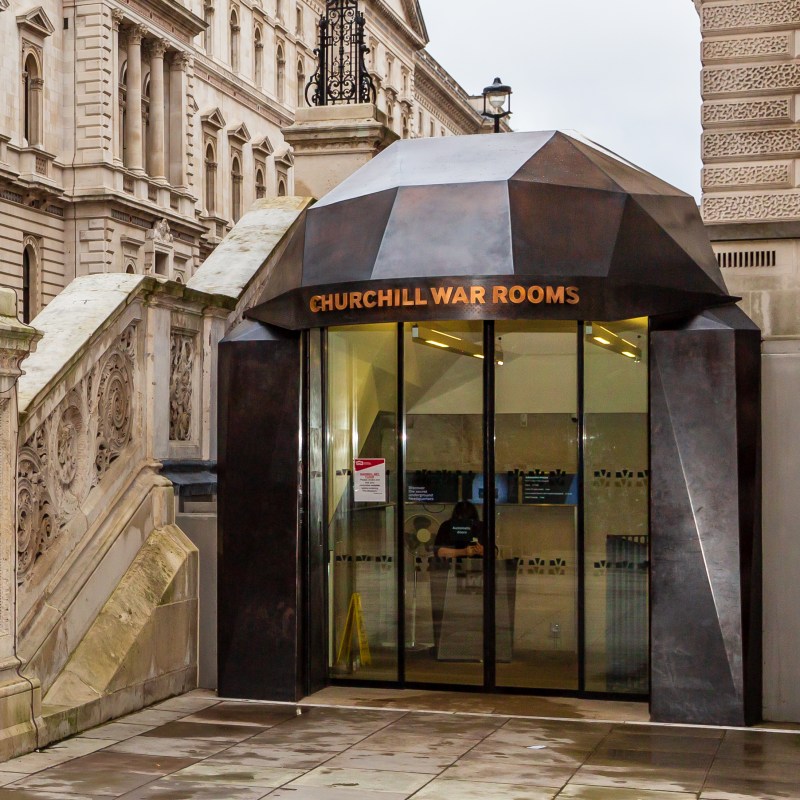
For more than seven decades, Winston Churchill served his country; first in the military, then in Parliament, and eventually in two terms as prime minister. His first four years as prime minister have captured the imaginations of biographers and moviemakers alike. Fifty years after his death, movies continue to be made about the man and his leadership during World War II. As recently as 2017, two major studio movies were released, Churchill and The Darkest Hour.
Videos by TravelAwaits
One of the best ways to understand this period in history is by visiting the Churchill War Rooms in London. This time capsule, located under the Treasury, offers a glimpse into the life and leadership of Churchill during the war.
Here are just some of the reasons to make time for the Churchill War Rooms on your next trip to London.

You’ll Learn Why An Underground Bunker Was Necessary
The devastation of World War I left Britain fearing what a future war would bring. In 1920, military leadership developed a plan to evacuate top government officials from London in the event of a major attack. But due to concerns about how this would be received by the residents of London, the plan was scrapped. This led to the concept of an emergency shelter within London. In 1938, the New Public Offices building was selected as the location for this shelter, since it had a large basement and a strong steel frame.
Now the top government and military officials had a secure place from which to direct war efforts. In 1939, one week before Britain declared war on Germany, the Cabinet War Rooms became fully operational. This space would be used until 1945. During the six years it was in use, there were frequent expansions to accommodate the growing staff needed to support Churchill and his top ministers and military leaders.

You’ll Get To Travel Back In Time To The 1940s
After the lights were turned out on the Churchill War Rooms in 1945, the space was left largely untouched for decades. In 1984, the space was opened as a museum under the management of the Imperial War Museums. As a result, visitors now have a glimpse of life in the 1940s.
Visitors to the Churchill War Rooms can witness the work spaces and technology of the era. To manage the large volume of calls coming in for all the military and government leaders, a switchboard room and a fleet of operators were needed. Another room is full of desks with typewriters that would have been occupied by women preparing reports for upcoming meetings. However, Churchill objected to the noise of the original typewriters used in the basement, so brand-new Remington “noiseless” models were imported from the United States.
The map room contains many telephones, some of which are fitted with scramblers, or devices intended to block others from overhearing calls. The new technology was very helpful in the 1940s, but unfortunately, it took up to 20 minutes for the scrambling device to warm up before each use; this made emergency calls impossible.

It Was The Center Of British Operations During World War II
One of the first rooms visitors see is the Cabinet Room. Here, Churchill, his government ministers, and the heads of the military branches gathered 115 times to discuss all aspects of the war.
The Cabinet Room tables and chairs are set up in a large square, with the exception of three chairs placed in the center of the room. These were the “hot seats” for the heads of the Navy, Army, and Air Force. They sat facing Churchill so that he could look them in the eye as he peppered them with questions about progress and strategy.
The busiest and most important room during the war was the Map Room, with desks and phones filling the center of the room and paper maps covering the walls. It was here that the progress of Germany’s troops was tracked.

You’ll Get A Taste Of Life Underground
Life in the underground bunker was tough. Many military and civilian staff members were expected to live in this dark, confined space. The size of the bedrooms coincided with rank, and the lowest-level personnel were relegated to tiny living quarters. Needless to say, privacy was limited.
Staff living underground had limited exposure to the sun, so they were expected to periodically stand in their underwear and protective eyewear in front of a sun lamp. Unfortunately, the sun lamp technology was new and unrefined, so sunburns often resulted from the overly strong light.
However, the men and women who lived there were deeply committed to their work, despite the uncomfortable setting. They knew they were a part of the war effort and were proud of it.
The Churchill War Rooms also provide a look at Churchill’s life during the war. He had his own bedroom and one for his wife, Clementine. However, Churchill didn’t enjoy being underground all night and would frequently slip out and sleep in a bedroom next to his aboveground office instead.
In a small kitchen nearby, Churchill’s personal chef, Georgina Landemare, prepared meals. This highly respected chef had offered her services to Churchill and his wife during the war despite the cramped conditions and the need to prepare meals from rations.

You’ll Learn About The Legacy Of Winston Churchill
Halfway through the tour of the War Rooms, visitors are encouraged to enter the Churchill Museum. Opened in 2005, the museum covers all 90 years of Churchill’s life, including his lonely childhood, his military and political careers, and his retirement. Hundreds of items are displayed, including his military uniforms, smoking jacket, favorite cigars, and the door of No. 10 Downing Street. The museum also features video and audio recordings of important moments in Churchill’s life.
The museum delves deep into Churchill’s life and legacy. During World War II, Churchill was perceived worldwide as a hero, but his overall legacy is much more complicated.
Over the course of his career, Churchill entered the army, ran for public office, worked as a war correspondent, wrote a novel, led and modernized the Navy, and served twice as prime minister of Britain. There were many successes, but also many failures. He switched party affiliation twice, a move that was both unusual and controversial.
A highlight of the Churchill Museum is The Lifeline, a high-tech, 50-foot touchscreen table that allows visitors to scroll through thousands of documents and photos from Churchill’s life and career. Not only is The Lifeline loaded with great details about Churchill, but it also shows world events that were taking place at the same time. It does an excellent job putting Churchill’s life and legacy in context.

You’ll Have Valuable Historical Context For Your London Vacation
It’s impossible to visit London and not hear about Churchill. And while most people have a general idea of his role in history, many don’t know the details.
A trip to the Churchill War Rooms is an excellent way to learn more about the man who thwarted Hitler’s Third Reich. It’s also a great opportunity to peer inside the place where victory was discussed, plotted, and eventually achieved. Many other sights in London relate to this critical time in history, and the War Rooms provide valuable context.

How To Visit The Churchill War Rooms
The Churchill War Rooms have become increasingly popular with visitors to London, so purchasing a timed ticket online in advance is recommended. If possible, arrive close to opening at 9:30 a.m. The website recommends allowing at least 90 minutes for a visit, though many people stay longer due to the large number of exhibits.
This isn’t an ideal museum for young children, but it’s a great option for older children and those who have recently studied World War II in school.
London bound? Don’t miss these 10 free museums in the city. And when you’re ready for a break from the hustle and bustle, consider one of these eight amazing day trips from London.
